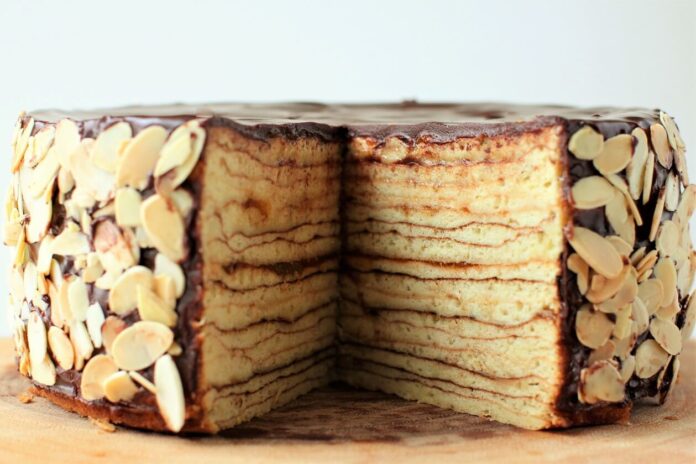
Ready for Christmas? Try a horizontal version
We are all familiar with the traditional Lithuanian wedding cake, commonly called “raguolis” (horned cake) or “šakotis” (branch cake). But it is also popular in Lithuania for other festivities, especially Christmas. This year, apparently, prices vary from 14 to 17 euros per kilogram (one euro more than last year). Standard cakes weigh a few kilograms, while a big šakotis for a festive dinner can be 8 kg or more.
It keeps well, and can also be frozen. Baumkuchen (Tree Cake) is its German name, referring to the characteristic rings as seen in the cross-section of a tree. It is also a popular dessert in Japan.
Traditionally, raguolis is made on a spit by brushing even layers of batter on a rotating spit above or adjacent to a heat source. Each layer is allowed to brown before a new layer of batter is poured. A typical raguolis is made up of 15 to 20 layers of batter. However, the layering process can continue until the cakes are quite large. Skilled pastry chefs have been known to create cakes with 25 layers and weighing over 100 pounds (45 kg). When cooked on a spit, it is not uncommon for a finished raguolis to be 3-4 feet (0.91-1.22 m) tall.
Ingredients are typically butter, eggs, sugar, vanilla, salt, and flour. Baking powder is not considered a traditional ingredient. The recipe can be varied by adding other ingredients, such as ground nuts, honey, marzipan, nougat and rum or brandy, to the batter or filling between layers. It may be covered with sugar or chocolate glaze. In some (German) recipes, the fully baked and cooled cake is first coated with marmalade or jam, and then covered with chocolate. In Germany this cake is considered the “King of Cakes“.
It is highly disputed who made the first Baumkuchen and where it was first baked. One theory is that it was invented in the German town of Salzwedel. Another theory suggests it began as a Hungarian wedding cake. In Ein new Kochbuch (lit. “A New Cookbook”), the first cookbook written for professional chefs by Marx Rumpolt, there is a recipe for raguolis. This publication puts the origin of Baumkuchen as far back at 1581, the year the cookbook was first published. Marx Rumpolt had previously worked as a chef in Hungary and Bohemia.
Raguolis is one of the most popular pastries in Japan, where it is called baumukūhen. It is a popular wedding favour for guests because of its ring shape. It was first introduced to Japan by the German Karl Joseph Wilhelm Juchheim. Juchheim was in the Chinese city of Tsingtao during World War I and when the war ended the Japanese Army moved him and his wife to Japan. Juchheim started making and selling the traditional confection at a German exhibition in Hiroshima in 1919. Continued success allowed him to move to Yokohama and open a bakery there.
A simpler, horizontally layered version of the cake is called a “Schichttorte”. It is baked without a spit in a springform pan. The horizontally layered version results in a raguolis that is more similar in shape to conventional cakes. It can be baked in a household oven under the broiler.
It may be too late to order a true raguolis for this Christmas, but here is a recipe that can be made at home, with a bit of patience – but no special equipment.
“Horizontal“ Raguolis
(From Treasures of Lithuanian Cooking)
- ½ cup butter
- ½ cup sugar
- ½ tsp lemon zest
- ½ tsp vanilla
- 6 egg yolks
- ⅔ cup flour
- ⅓ cup corn starch
- 6 egg whites
- ¼ tsp salt
- ¼ cup sugar
- 2 cups sour cream
- ⅓ cup sugar
- 1 tsp vanilla
Grease a 9-inch springform pan. Cream butter until light, gradually add ½ cup sugar, then lemon zest and vanilla. Add yolks, one at a time, beating well after each addition. Mix flour, 1/3 cup cornstarch and ¼ tsp salt, stir into butter mixture.
Beat egg whites until soft peaks form, then gradually add ¼ cup sugar. Continue beating until stiff peaks form. Stir a small amount of egg white into the flour mixture. Fold flour mixture into egg whites.
Spread a scant ½ cup of batter evenly on the bottom of the pan. Place under broiler, 5 inches from element. Broil 1 to 1½ minutes or until lightly browned. Remove from oven, spread another ½ cup batter over browned layer, broil again. Repeat this step, making 5 layers. Mix sour cream, remaining ⅓ cup sugar and vanilla. Spread half of this mixture over the top cake layer. Broil 1 minute, or until set. Using remaining batter, add 5 additional layers, broiling as before. Spread last layer with remaining sour cream mixture. Broil 1 minute or until set. Cool 15 minutes. Remove grom spring form pan, cool completely. Decorate with chocolate or other desired topping.
Skanaus!





























